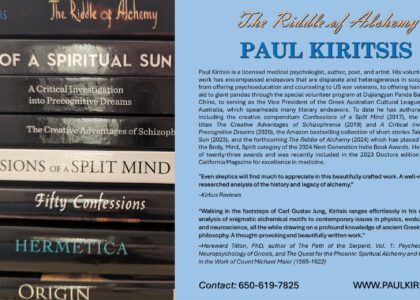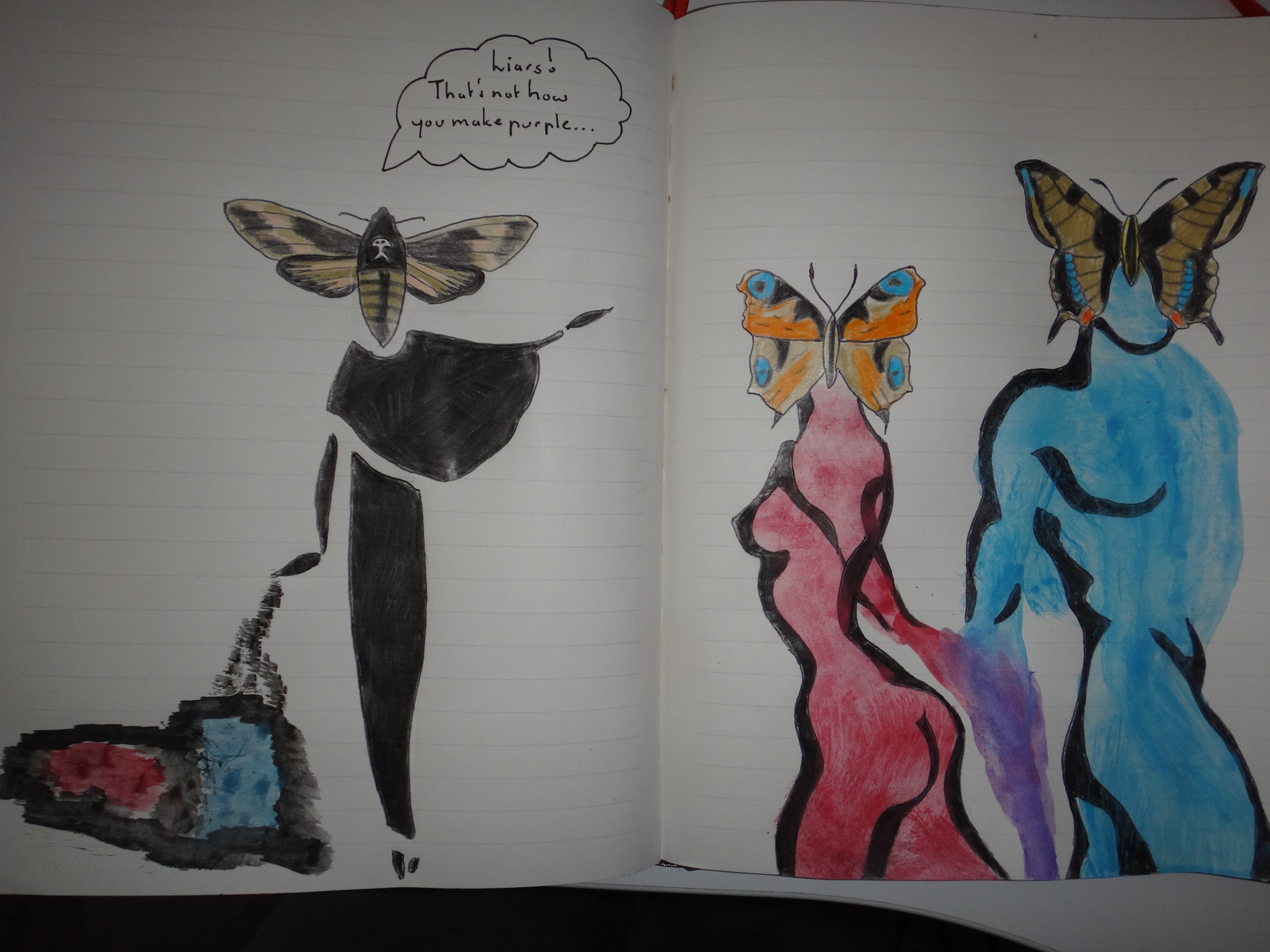
In the alchemical opus coagulatio transcribes the process whereby a liquid is chemically transposed into a solid state. The allusion to hardening and of going from an unconditional to a conditional state of existence is inexplicable linked with creation as a churning act of incarnating spirit or coming into being. All cosmogonic myths attempting to explain the origin of the universe and the birth of humankind; all conjunctions of Sol and Luna depicted in alchemical treatises across the ages; and all solidifications of subterranean magma into igneous rock after it has violently erupted onto the surface of the earth represent a particular aspect of this cosmological leitmotif.
Transposed to the psychological echelon, coagulatio is the fixed point at which the self-conscious ego and the transpersonal Self meet and interact. According to the laws of Jungian individuation, the sulfurous principle or dynamic impulse of desirousness aches for expression and binds the personal ego to the earthbound plane by facilitating an awareness of the shadowy aspects of one’s own inner nature. This discrimination of opposites, of playing off corresponding qualities–black and white, good and evil, and masculine and feminine–off against one another to create spatiotemporal and consensual reality as we recognize it is a maleficent, criminal process because it introduces the concept personification into existence. In this state all things and aspects of the cosmos are no longer operating in unconscious unison and concord; the gravity of one’s perception shifts from ‘we’ and ‘us’ to an egocentric situation of ‘I’ or ‘me’ versus an ambient background of multilayered fields, establishing the archetypal blueprints of an inner realm known esoterically as the microcosm as separate form an outer phenomenal world recognized by all as the macrocosm. As we individuate or self-actualize the conscious standpoint expands to accommodate a proliferating bundle of transpersonal projections emerging from the unconscious together, strengthening the essence of the contracted ego exponentially. Everything standing outside of that congealed essence is a potential threat to its secular sanctuary, a malignant ‘evil’ to be reckoned with.
One of the best ways to identify coagulatio (the confinement to personal space or material reality) in a client’s or analysand’s life process is through altered states of consciousness like dreams and hypnagogia. Telepathic images involving social transgressions, aviation disasters, or things materializing in the sky and raining down around the client are some of the most powerful symbols associated with coagulatio. So too are unremarkable and common aspects of day-to-day living like putting on clothes, building edifices for residence, and eating food. The Jungian analyst Edward Edinger who dedicated a whole chapter to coagulatio in his book Anatomy of the Psyche: Alchemical Symbolism in Psychotherapy elucidates that to eat or scoff down food in your dreams telepathically connotes the reality that unconscious archetypal content is about to be projected into consciousness by the ego. On the other hand, motifs that have to make do with the establishment of human relationships and all matters concerning them are also coagulatio themes. To form a relationship with somebody or something means to render a transpersonal force personal and then incorporate it into the same patterned interface of entwining and interconnected dichotomies appropriated by all embodied minds to make sense out of the world. The concretization of psychic forces characteristic of coagulatio themes such as the ones just mentioned is of utmost importance in psychotherapy as well as in the formative development of an individual, for without it schizophrenia and a whole continuum of other psychological conditions loosely banded under the label of psychosis materialize. Acute fixations are problematic and dangerous but an inability on the part of our internal psychic mechanisms to congeal them is even more consequential. I guess the line separating creation and order from destruction and chaos is a lot finer than we perceive it to be.
In the realm of transpersonal therapy, coagulatio is associated with the hardening up of archetypal contents that broke through the thick layers of unconsciousness during the solutio phase or the third nigredo. Owing to the steepness of this descent, the coming-to-consciousness of deeper shadowy horrors makes coagulatio an acrimonious and wretched stage in the alchemical cycle. Psychic projections rising from the collective unconscious to establish the new ego-self bring with them the arcane knowledge of why previous suicidal self-annihilations came about in the first place as well as the realization that emancipation, amalgamation, and transfiguration knows no definitive cosmological grounding. Moreover, the analysand might all of a sudden awaken to the notion that the personal ego-conscious is something of an illusion, a Midwestern farmhouse never quite safe from spiritual tornadoes liable to funnel their way into reality and wreak havoc at any moment.
There is something entirely negative and problematic about embracing the individuation process with open arms; the fact that knowledge of its laws are congealing under the aegis of a much more exalted ego now limits and imprisons consciousness within narrower psychospiritual demarcations and emasculates other creative potentialities yearning for expression. In actual fact, acquisitions of form or concretely actualizing psychic energies almost always evoke a sense of necrotic detachment from the Adamic perfection and infinite spectrum of creative impulses brewing in the unconscious. What this means is that once matter has been defined and named it loses its spark, its wonder, its mystifying nature, and its enchantment. In other words it suffers inertia and becomes lifeless. Any loss that involves the destruction of such instrumental life qualities as beauty and sympathetic resonance to all of creation as a whole is bound to be a saddening and disheartening experience for the individual psyche. Remaining resolute and stoic in the face of such losses is possible because we spend our lives oblivious to the conception that they’re an omnipresent aspect of consciousness and forever transpiring.
For the most part, the coagulatio subjects the counsellor-client synergy to a morbid acceleration of the transference-countertransference cycle. This is due to the fact that previously rejected content is now emerging from the cavernous depths of the unconscious, connecting and imbuing the client’s most excruciating past and present life experiences with meaning. The meaningfulness, initially perceived as a vice, places an enormous amount of stress on an affiliation loosely held together by professional bonds and obligations and tests its endurance. Regrettably, the unconscious act of transmuting transpersonal energies into ‘earth’ and thus rendering the hitherto undeciphered roots of very dark psychological problems and neuroses comprehensible is no assurance of salvation. New material pouring forth is likely to be the catalyst for experiences both favourable and unfavourable, producing feelings of ambivalence that the client might easily mistake for misguidance, a distortion of the phenomenology of experience, or just plain apathy towards his or her emotional welfare. The spontaneous inversion of an attitude that has now gone from honouring, respecting, and exalting the facilitating counsellor to perceiving him or her as an implement of the devil can be infuriating and patience-testing for the latter.
Because the movement from the albedo or whiteness to citrinitas or yellowing involves a lateral shift which is not polar in nature and unprecedented, the client may become stuck in a semi-permanent state of delusional dejection and develop a false conviction that the therapeutic endeavour has been derailed by darkness and will never again realign with the tunnel leading out into the spiritual light. During this ‘dark night of the soul’, it’s not at all uncommon for an analysand to attack the mediating counsellor with statements like, “Do you actually know what you’re doing or are you trying to drive me mad intentionally?” or “I feel like you don’t understand me anymore. What’s gotten into you?” If the counsellor cannot correct these unfounded perceptions by actively applying his or her sphere of self-knowledge and past experiences to the therapeutic method, three things are bound to eventuate: firstly, the professional relationship will be rocked right down to its very foundations; secondly, the clarifying vision of the albedo will escape like a beautiful white dove from an opened birdcage; and finally the final breakthroughs anticipated in the next stage will forever remain an unrealized aspiration.
Throughout this later phase, the personal ego begins to bridge many previously unconnected experiences and make sense out of them in the manner that a pre-schooler methodically joins all the points in a connect-the-dot-puzzle to form an image perceptible to its intellect. Often deeply traumatic phenomena thrust to the slimy seabed of the collective unconscious and under rug swept for extended epochs of one’s life will announce themselves like spiritual emergencies. Aided by the counsellor’s continual synthetic and calculated probing, childhood memories associated with sexual, physical and emotional abuse may incite the personal dreambody into action which begins churning them out from beneath the psychic lithosphere of suppression, detachment, and amnesia through telepathic and kinaesthetic conduits. Beginning as vague tingling sensations in the dark pits of oblivion they diffuse across into the imaginal world, into the realm of symbols and archetypes and manifest there as a whole continuum of dreams and hypnagogic images before entering contracted state of ordinary waking consciousness as transcribed chronological sequences of spatiotemporal events called memories. These thicken and congeal and become as palpable as a shiner obtained during a violent midnight brawl at the local pub. Major inroads into some of the most harrowing and mysterious psychological conditions like dissociative identity or multiple personality disorder (also known as split personality) are more than likely to eventuate during this deeper and heavier alchemical stage. Given that the hermetic fires and heat that reduce preeminent ‘forms’, projections, and psychic contents into prima materia are at their fiercest in the third and last putrefactio, it makes sense that the likelihood of fusing fragmented subpersonalities operating independently with the dominant host personality or into a former ego pattern would increase exponentially here.
Under immense pressure coming from the fiery element, metals bend and break and pieces of glass fuse together. So too do the ingredients brewing in the personal container called the psyche.








